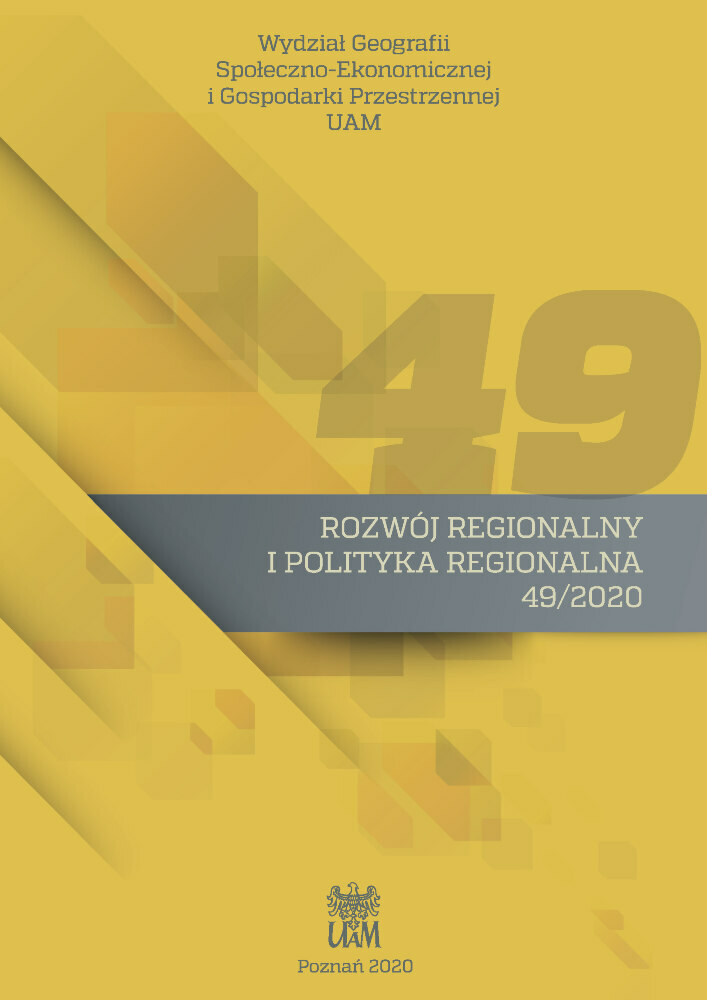Abstrakt
Koncepcja środowiskowej krzywej Kuznetsa (EKC) odnosi się do zależności pomiędzy rozwojem gospodarczym, najczęściej wyrażanym wartością PKB per capita, a degradacją środowiska. Graficzna prezentacja klasycznej postaci krzywej przypomina kształt odwróconej litery „U”. Na kształt krzywej wpływa jednak wiele czynników, stąd powszechna krytyka założenia i próby wykorzystania różnorodnych modeli do weryfikacji zależności. W artykule dokonano przeglądu i analizy współczesnych badań z zakresu weryfikacji koncepcji EKC. Dyskusji poddano przesłanki teoretyczne oraz podejście metodyczne, porównano wykorzystane zmienne objaśniane (stan środowiska) i objaśniające, wielkość próby badawczej, zakres czasowy oraz wyniki badań uzyskane przez badaczy weryfikujących koncepcję EKC. Szczególną uwagę poświęcono możliwości wykorzystania EKC do badań na poziomie regionalnym i lokalnym.
Bibliografia
Al-Mulali U., Ozturk I. 2016. The investigation of environmental Kuznets curve hypothesis in the advanced economies: the role of energy prices. Renewable and Sustainable Energy Reviews, 54: 1622–1631.
Antczak E. 2014. Estymacja przestrzenno-czasowej środowiskowej krzywej Kuznetsa za pomocą re¬gresji ważonej geograficznie. Collegium of Economic Analysis Annals, (34): 11–25.
Chowdhury R.R., Moran E.F. 2012. Turning the curve: A critical review of Kuznets approaches. Ap¬plied Geography, 32(1): 3–11.
Ciriaci D., Palma D. 2010. Geography, environmental efficiency and Italian economic growth: a spa¬tially-adapted Environmental Kuznets Curve.
Cole M.A., Rayner A.J., Bates J.M. 1997. The environmental Kuznets curve: an empirical analysis. Environment and Development Economics, 2(4): 401–416.
Daly H.E. 2005. Economics in a full world. Scientific American, 293(3): 100–107.
Dinda S. 2004. Environmental Kuznets curve hypothesis: a survey. Ecological Economics, 49(4): 431–455.
Emerson T.L., Pendleton L.H. 2004. Income, environmental disamenity, and toxic releases. Economic Inquiry, 42(1): 166–178.
Europejska Agencja Środowiska 2012. Kluczowe problemy środowiskowe, z którymi musi zmierzyć się Europa (2012). Sygnały 2012 EEA, Kopenhaga.
Gómez-Baggethun E., De Groot R., Lomas P.L., Montes C. (2010). The history of ecosystem services in economic theory and practice: from early notions to markets and payment schemes. Ecological Economics, 69(6): 1209–1218.
Grossman G.M., Krueger A.B. 1995. Economic growth and the environment. The Quarterly Journal of Economics, 110(2): 353–377.
Gruszecki L., Jóźwik B. 2019. Teoretyczne rekonstrukcje środowiskowej krzywej Kuznetsa. Gospodar¬ka Narodowa, 299(3): 95–117.
Islam N., Vincent J., Panayotou T. 1999. Unveiling the income-environment relationship: An explo¬ration into the determinants of environmental quality. Harvard Inst. for Internat. Development.
Jankowska E. 2016. Środowiskowa krzywa Kuznetsa w dekarbonizacji europejskich gospodarek. Studia Ekonomiczne, 289: 51–61.
Jean-Paul F., Martine D. 2019. Poza PKB. Mierzmy to, co ma znaczenie dla rozwoju społeczno-gospo¬darczego. OECD Publishing.
Kahuthu A. 2006. Economic growth and environmental degradation in a global context. Environ¬ment, Development and Sustainability, 8(1): 55–68.
Kassenberg A. 2011. Globalne problemy ekologiczne i ich konsekwencje dla rozwoju gospodarczego. Biuletyn PTE, (2): 52.
Kukla-Gryz A. 2004. Weryfikacja hipotezy o „środowiskowej krzywej Kuznetsa” na przykładzie emisji dwutlenku węgla w krajach OECD. Ekonomia/Uniwersytet Warszawski, (13): 113–135.
Lieb C.M. 2004. The environmental Kuznets curve and flow versus stock pollution: the neglect of future damages. Environmental and Resource Economics, 29(4): 483–506.
Meers R. 2000. A test of the environmental Kuznets curve for local and global pollutants.
Nowak-Far A. 2014. Krzywa Kuznetsa a wielość jurysdykcji fiskalnych. Studia z Polityki Publicznej, 1(1): 57–79.
Pablo-Romero M.P., Cruz L., Barata E. 2017. Testing the transport energy-environmental Kuznets curve hypothesis in the EU27 countries. Energy Economics, 62: 257–269.
Pakulska J. 2002. Środowisko przyrodnicze w rozwoju gospodarczym. Prace i Materiały Instytutu Rozwoju Gospodarczego SGH, 72: 295–308.
Panayotou T. 2016. Economic growth and the environment. The Environment in Anthropology, 140–148.
Park S., Lee Y. 2011. Regional model of EKC for air pollution: Evidence from the Republic of Korea. Energy Policy, 39(10): 5840–5849.
Pasten R., Figueroa E. 2012. The environmental Kuznets curve: a survey of the theoretical literature. International Review of Environmental and Resource Economics, 6(3): 195–224.
Perrings C. 2003. The economics of abrupt climate change. Philosophical Transactions of the Roy¬al Society of London. Series A: Mathematical, Physical and Engineering Sciences, 361(1810): 2043–2059.
Stern D.I. 2004. The rise and fall of the environmental Kuznets curve. World Development, 32(8): 1419–1439.
Stern D.I., Common M.S., Barbier E.B. 1996. Economic growth and environmental degradation: the environmental Kuznets curve and sustainable development. World Development, 24(7): 1151–1160.
UNEP. 2016. Global Environment Outlook (GEO-6) Assessment for the pan-European region. United Nations Environment Programme, ONZ.
Yandle B., Vijayaraghavan M., Bhattarai M. 2002. The environmental Kuznets curve. A Primer, PERC Research Study, 02–01.
Williamson C. 2017. Emission, education, and politics: an empirical study of the carbon dioxide and methane environmental Kuznets curve. The Park Place Economist, 25(1), 9.
Licencja
Copyright
© 2020 WGSEiGP, Uniwersytet im. Adama Mickiewicza w Poznaniu
OPEN ACCESS
